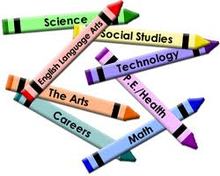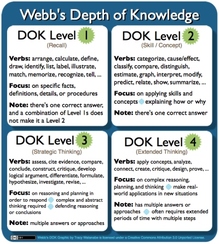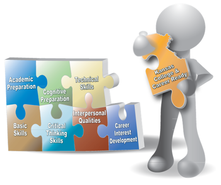English Language Arts (ELA)
The basis of the ELA standards are the Anchor Standards for Reading, Writing, Speaking and Listening, and Language. These anchor standards are broad in scope and are designed to establish what every student is expected to know and be able to do by the time they graduate from high school. The anchor standards are applied K-12, with grade level standards for each strand that break down the anchor standards into appropriate skills and content for that particular grade level. The rigor (difficulty and complexity) increases as students advance through the grades preparing for graduation. How these skills are taught is up to the school (local control) as defined by their curriculum and acceptable practices.
In addition to the strands most closely associated with reading and language arts content, a section devoted to History/Social Studies, Science and Technical Subjects is also a part of the ELA standards. The emphasis of all the ELA standards as well as those for non-English subject areas is to promote literacy.... the ability to communicate and use what you know and understand. This applies to all content areas and is the responsibility of all teachers to ensure content literacy through the tools and skills learned in the ELA standards.
The ELA Standards address the fundamentals of reading (foundations) in elementary grades; the reading of literary and informational text; writing; speaking and listening; and language K-12. The History/Social Studies, Science and Technical subjects apply to grades 6-12.
In addition to the strands most closely associated with reading and language arts content, a section devoted to History/Social Studies, Science and Technical Subjects is also a part of the ELA standards. The emphasis of all the ELA standards as well as those for non-English subject areas is to promote literacy.... the ability to communicate and use what you know and understand. This applies to all content areas and is the responsibility of all teachers to ensure content literacy through the tools and skills learned in the ELA standards.
The ELA Standards address the fundamentals of reading (foundations) in elementary grades; the reading of literary and informational text; writing; speaking and listening; and language K-12. The History/Social Studies, Science and Technical subjects apply to grades 6-12.
Getting Started on ELA

- Overview of ELA Standards
- Anchor Standards for College and Career Readiness
- Understanding the concept of Literacy in the Content Areas
- Applying Knowledge & Skills
- How this will change your teaching and student learning
Implementation Plan for ELA

- Unpacking the standards - what are they telling us?
- Unit Planning
- Integrating content areas
- Cross-curricular involvement
- Focusing on Literacy, Higher Level Thinking, and Independent Learning
LITERACY IN ALL CONTENT AREAS

Literacy in all content areas is the goal of the Common Core and should have been the goal for all subject areas all along! We define literacy as more than just comprehension, but also the ability to create meaning and communicate this knowledge in multiple ways. Writing and speaking jump to the forefront as effective communication tools. We have unfortunately depended on short answer, multiple choice, and other narrow forms of assessment to determine what a student knows. What we figured out is that they can memorize but not necessarily understand.
Literacy, therefore, requires us to have students provide us with richer evidence of what they know and can do with the knowledge and skills they possess. This can and should be apparent in all content areas. Everyone wants their students to master the content and the skills of their subject matter. "Hands on" subjects have long been able to have students demonstrate understanding in an application format, but they often miss the communication piece that would allow students to express their understanding to others, or assess their knowledge and skills in other situations. Core subjects have relied on tests, or perhaps the written word, but have failed to help students orally communicate their understanding, or show it in a more creative format, limiting them to the knowledge at hand, as opposed to how that knowledge could be used in other circumstances. In all content areas we have often failed to have students defend their answers or choices with acceptable evidence or require them to judge the accuracy or reliability of what they see, read, or hear.
There are many essential skills that are emphasized in the Common Core to prepare students for the college experience and careers, that are also key to the goal of literacy. Consider the list below (noting that there are many more skills that could be included).
Literacy, therefore, requires us to have students provide us with richer evidence of what they know and can do with the knowledge and skills they possess. This can and should be apparent in all content areas. Everyone wants their students to master the content and the skills of their subject matter. "Hands on" subjects have long been able to have students demonstrate understanding in an application format, but they often miss the communication piece that would allow students to express their understanding to others, or assess their knowledge and skills in other situations. Core subjects have relied on tests, or perhaps the written word, but have failed to help students orally communicate their understanding, or show it in a more creative format, limiting them to the knowledge at hand, as opposed to how that knowledge could be used in other circumstances. In all content areas we have often failed to have students defend their answers or choices with acceptable evidence or require them to judge the accuracy or reliability of what they see, read, or hear.
There are many essential skills that are emphasized in the Common Core to prepare students for the college experience and careers, that are also key to the goal of literacy. Consider the list below (noting that there are many more skills that could be included).
- Reading (independent, including text complexity)
- Writing
- Speaking
- Listening
- Presentation
- Independent learning (text engagement, research, analysis)
Depth of Knowledge TOOLS |
UNPACKING TOOLS |
LITERACY RESOURCES FOR ALL CONTENT AREAs
 Created by Tracy Watanabe
Created by Tracy Watanabe
Common Core Video Exemplars from Teaching the Core Search for content areas (Math, Reading/ELA, Science & Social Studies) and grade level videos for instructional ideas and strategies.
Live Binders: Common Core Resources for Physical Education (and much, much more!!!) This resource not only contains Common Core, Literacy, and Writing information that can apply to any content area, but also includes PE content, rubrics, and lesson plan information.
A Guide to Depth of Knowledge: 5 Tips to Help Your Students In this ASCD Edge blog post, Suzanne Klein, Executive Director in Grandville, MI, breaks down how Depth of Knowledge levels 3 and 4 align with the rigor required by the Common Core ELA Standards. Klein notes that to attain this level, writing will be an important tool for students. Writing is not just a mechanical formula. It requires that students be able to think and synthesize what is read or known. She shares practical ideas and strategies that can be used to assist students as they write at the third and fourth levels of Depth of Knowledge. These strategies can be applied for all grade levels.
Close Reading: 10 Tips For Close Reading Activities Close Reading is an expectation of Common Core (Kansas College and Career Ready Standards). It requires students to look more deeply at the reading passage(s) they use for class. Here are some useful tips to achieve this goal.
Another Close Reading Strategy: 10 Intriguing Photographs to Teach Close Reading and Visual Thinking Skills. The use of pictures to spark interest has been a growing strategy as we ask learners to ask questions, wonder, and make connections to new and previous learning. This article takes that strategy further as the author, Michael Conchar, offers 10 ideas on how to use photographs to deepen the thinking and consequently the interest and the learning.
Taking Note Taking Skills to the 21st Century. This article packed full of ideas, includes embedded videos on the "How to" of note taking by using visuals along with the necessary writing to help students make deeper connections.
More coming soon!...
*Teaching and Learning Consulting Network, LLC does not endorse or determine reliability of claims of effectiveness or alignment. Information is intended only for reader consideration.
Live Binders: Common Core Resources for Physical Education (and much, much more!!!) This resource not only contains Common Core, Literacy, and Writing information that can apply to any content area, but also includes PE content, rubrics, and lesson plan information.
A Guide to Depth of Knowledge: 5 Tips to Help Your Students In this ASCD Edge blog post, Suzanne Klein, Executive Director in Grandville, MI, breaks down how Depth of Knowledge levels 3 and 4 align with the rigor required by the Common Core ELA Standards. Klein notes that to attain this level, writing will be an important tool for students. Writing is not just a mechanical formula. It requires that students be able to think and synthesize what is read or known. She shares practical ideas and strategies that can be used to assist students as they write at the third and fourth levels of Depth of Knowledge. These strategies can be applied for all grade levels.
Close Reading: 10 Tips For Close Reading Activities Close Reading is an expectation of Common Core (Kansas College and Career Ready Standards). It requires students to look more deeply at the reading passage(s) they use for class. Here are some useful tips to achieve this goal.
Another Close Reading Strategy: 10 Intriguing Photographs to Teach Close Reading and Visual Thinking Skills. The use of pictures to spark interest has been a growing strategy as we ask learners to ask questions, wonder, and make connections to new and previous learning. This article takes that strategy further as the author, Michael Conchar, offers 10 ideas on how to use photographs to deepen the thinking and consequently the interest and the learning.
Taking Note Taking Skills to the 21st Century. This article packed full of ideas, includes embedded videos on the "How to" of note taking by using visuals along with the necessary writing to help students make deeper connections.
More coming soon!...
*Teaching and Learning Consulting Network, LLC does not endorse or determine reliability of claims of effectiveness or alignment. Information is intended only for reader consideration.
ELEMENTARY ELA RESOURCES

This link provides resources for Anchor Standard 7 (Multi-media) that is applicable to K-5. Resources have been developed by Burkins & Yaris. Click here.
Think kindergarten students can't benefit from a deeper understanding? Think again! This article entitled, "Your Kindergartner's Reading Under the Common Core Standards," speaks to the importance of making connections between letter recognition, sounds, and combining letters to form words and how that transfers to comprehension and understanding of the use of letters to create meaning. This looks to be a great resource for parents and teachers alike!
*Teaching and Learning Consulting Network, LLC does not endorse or determine reliability of claims of effectiveness or alignment. Information is intended only for reader consideration.
Think kindergarten students can't benefit from a deeper understanding? Think again! This article entitled, "Your Kindergartner's Reading Under the Common Core Standards," speaks to the importance of making connections between letter recognition, sounds, and combining letters to form words and how that transfers to comprehension and understanding of the use of letters to create meaning. This looks to be a great resource for parents and teachers alike!
*Teaching and Learning Consulting Network, LLC does not endorse or determine reliability of claims of effectiveness or alignment. Information is intended only for reader consideration.
The Teaching and Learning Consulting Network, LLC
Supporting the quest to improve teaching and learning
Supporting the quest to improve teaching and learning